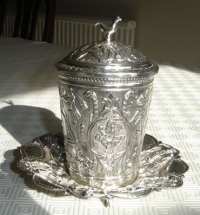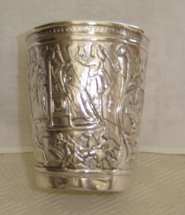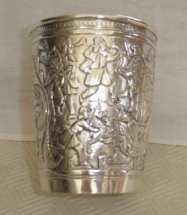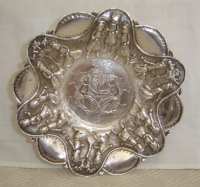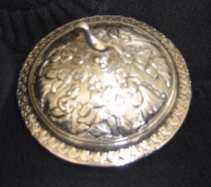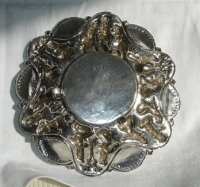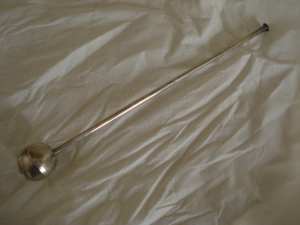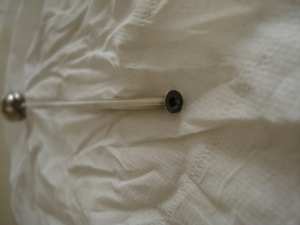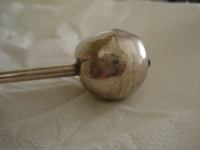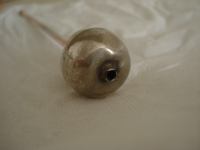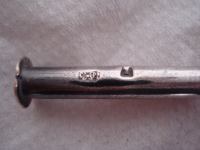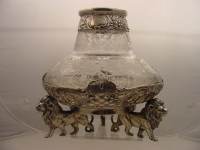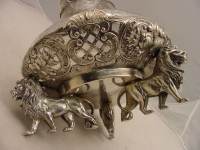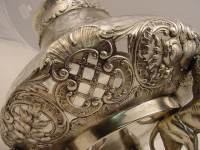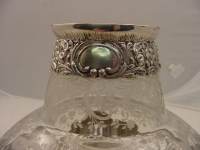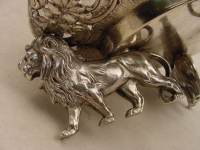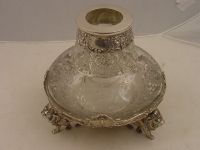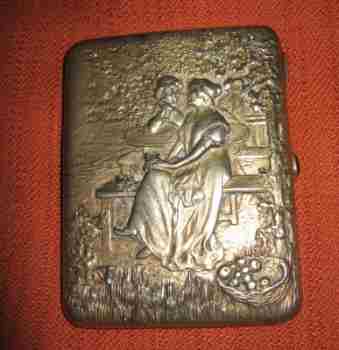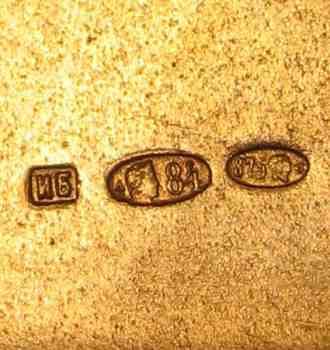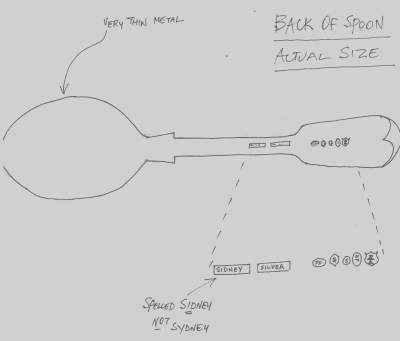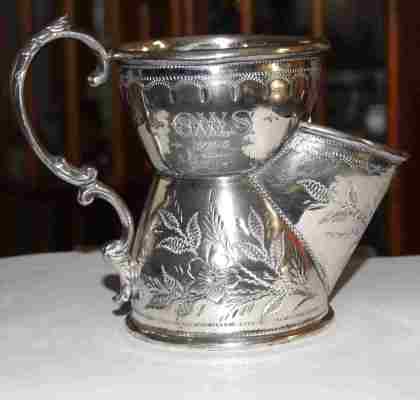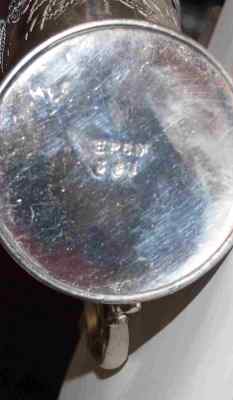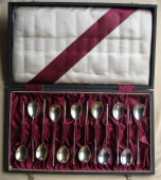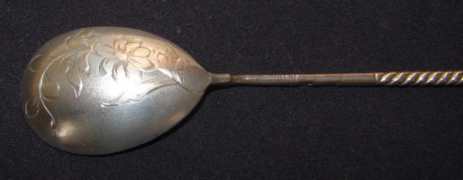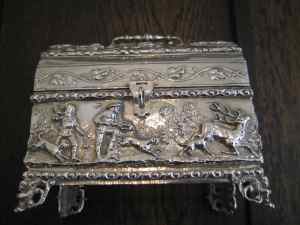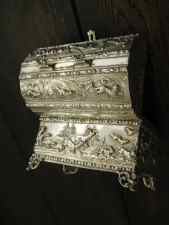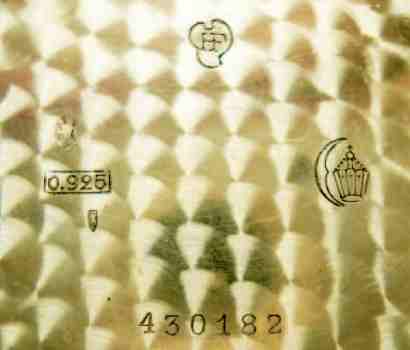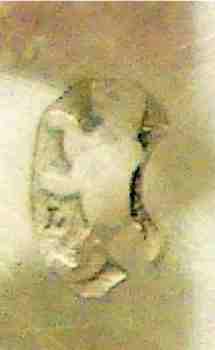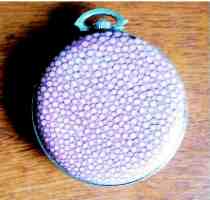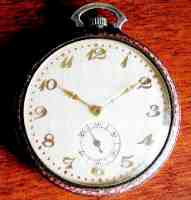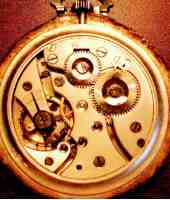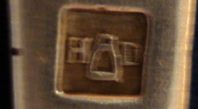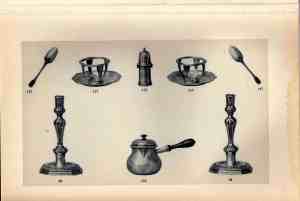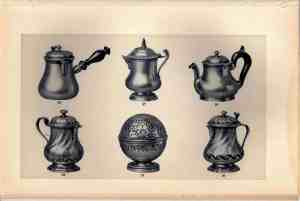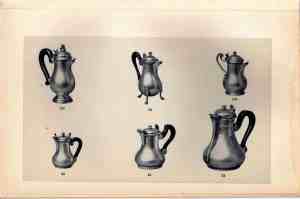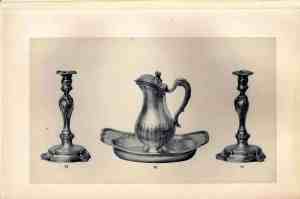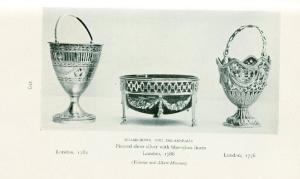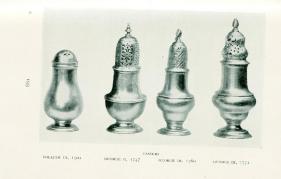| |

Robert Massart presents:
Scottish Legends & Silver Hallmarks

Scotland is well-known for his clans, the fearless
militaries going to the battlefield preceded by their
pipers and the unspoiled nature of the Highlands with
lochs, rivers, salmon and stags. During historical times
many myths, folk tales and legends originated in this
environment, even affecting today's practices of
hallmarking silver.
Deciphering marks on silver items is a fascinating
pastime for silver collectors, but mostly they have no
idea of the background of these marks and the reason why
specific punches were chosen as town mark or standard
mark. The scope of this article is to trace back the
origin of Scottish silver punches to the earliest times
and to bring the reader up-to-date on this subject.....
click here

|
Welcome to new ASCAS members:
Barry Arnol - Australia -
Josep S. Cooper - USA
Maura Graber - USA
Siddarth Chand Lall - England UK
Aaron Louis Kaufman - Australia -
Garry Middleton - Canada
Karen S. Rabe - USA
William Sharek - USA
Sandra Gray Schreiber - USA
Andrius Tamusonis - Lithuania
Maggie Wihnyk - USA
Bronia Wulich - Israel
Emmanuel van Zuylen van Nyevelt - Belgium
Members' Window # 59/1
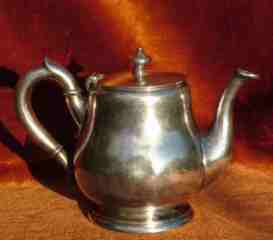
Prof. David N. Nikogosyan presents:
Marks of European Silver Plate: IV. Hacker & Herrmann,
Austria

First, let me cite von Kerssenbrock-Krosigk's and
Kanowski's book, Modern Art of Metallwork: "By 1898,
there were 230 factories and workshops for metalwork
alone in Vienna, the capital city of the
Austro-Hungarian Empire". However, after 1918, only
three firms continued the silver plate production: Art.Krupp
Berndorf, J.C.Klinkosch (already acquired by Berndorf)
and Wiener Werkstätte (Vienna Workshops). In the current
Member's Window I would like to present two little-known
silver plate factories, which were active in Vienna at
the end of the XIX - beginning of the XX centuries and
disappeared after WWI: Moritz Hacker and J.L.Herrmann.
Without doubt, they both truly represent the Secession
style, i.e. the Austro- Hungarian branch of Art Nouveau,
in silver-plated hollowware......
click here

|
Members' Window # 59/2
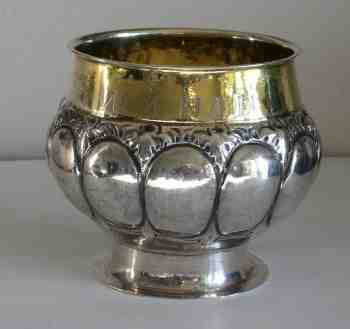
Kari Helenius presents:
A Swedish Bratina

This bratina (see information in
What is? Silver Dictionary)) has been marked by
silversmith Arwid Falk in Stockholm 1676 - 1691.
It measures: diameter 144mm, height 123mm, weight
388,3g, capacity 1200ml.
There is a scratching on the bottom: 91¼ no o/mn, which
could mean the weight in zolotnik. 91¼ z corresponds to
389,0g. The actual weight is 388,3g.
Because of this I believe that the bratina has been
exported to Russia. There are two French import marks
(the tiny swan mark) One on the foot and the other on
the upper rim. This means that the item has been brought
to France after 1893.......
click here

|
Tony Mason writes:
...I am seeking to identify and if possible value what appears
to be a Judaic Silver Ceremonial Set, illustrated in the
attachments. The cup without lid is 10cm high, 6cm base diameter
and 8cm top diameter; the tray is 15cm in diameter. The lid
includes in its detail captives chained by the neck. There are
no maker's marks. The piece was bought in a private sale in Iraq
in 1991.The condition is perfect.
The Judaic Ceremonial Set, if indeed that is what the piece is,
was bought by a Russian diplomat from an impoverished Iraqi
family in Baghdad in the early 1990s and given to me and my wife
in 1999. Only recently, during a survey of items in the
household collected around the world in a military career, did I
locate a similar item auctioned in Israel in 2008 and set out to
discover more about it.
I will be most grateful if you could give me any information
about it, or direct me to a location which could inform me.
Tony Mason
An uncommon piece. Any suggestion will be appreciated.
Giorgio Busetto
Andrew Brasch writes:
...can you help me to locate this silver mark. This is my new
acquisition.
Andrew Brasch
Carmelo Bruno Bruni writes:
... I'd wish to have information about this Russian cigarette
holder. It has Moscow 1908-1926 mark and IB (Cyrillic)
silversmith's mark. There is also another mark (head towards
right and 875) fully unknown to me.
Thank you for any help you can supply.
Carmelo Bruno Bruni
The silversmith is Ivan Butuzov, active in Moscow from
1895 to 1917. The "head towards right and 875" is a mark added
after the Soviet Revolution and used from 1927 to 1954, In this
case the silver fineness is indicated in thousandths instead of
in zolotnicks. I found bibliography illustrated only with a
similar mark (a worker with a hammer) and the title "583", but I
believe that also the "875" was used in this period.
Giorgio Busetto
Hugh Scrine writes:
Dear Mr Busetto,
I get the impression from your Website that your Association
comprises a group of people who know a great deal about silver
articles. Your site also gives the impression that you get a lot
of pleasure from the study of silver and the exchange of
information on this subject. I have found that knowledge that
arises from such enthusiasm is generally deeper and more
comprehensive than that which is available from people whose
only interest is a commercial one.
I hope I have interpreted your site correctly in that you may be
prepared to identify and inform on articles presented to you.
On this presumption I would appreciate it greatly if you were
able to tell me something about a Spoon that was given to me
many years ago , in New Zealand, as a gift, but which I had not
considered to be an article of any particular merit, until I
started giving the matter some thought only recently.
It is a spoon as displayed in the attachment to this E-Mail,
which I believe to be Australian because of the name SIDNEY
marked on the handle. This itself is a little unusual because
the Australian city is generally spelled SYDNEY. I am hoping you
may be able to assist me in learning something about the spoon.
Funny to think of Australian articles being considered "antiques"
when this country is only just over 200 years old (since the
British invasion).
I have searched the Web fairly exhaustively to try and find
Australian Hallmarks (if such exist) that may match the markings
on the spoon - but no luck. The "scoop" part of the spoon is
very thin metal and looks as if it has been hammered into shape
from a flat metal piece. It looks as if it is made of silver -
you would, no doubt, know from the markings if this is the case.
I noticed while browsing through spoon descriptions that the
value of some spoons can exceed USA$ 6000 - this would be a nice
surprise. Not that I would necessarily sell it, but it would be
useful additional information. There is, of course, the
possibility that articles from this "far flung remnant of a dead
Empire" may not excite any interest from your members and may
not form part of your collective knowledge of silver throughout
the world.
If you get time I would like to hear from you.
Regards
Mr Hugh Scrine
Perth - Western Australia
PS possibly I am incorrect in thinking "SIDNEY" refers to an
Australian town.......the spoon may be made in Mr Sidney's
workshop ??
I'm sorry, but I don't believe that your spoon has great
value. Its origin is UK and not Australia. It was made by James
Deakin & Sons of Sheffield in their Sidney Works in Matilda
Street (I believe at the end of the 19th century). Information
about the mark of your spoon and its maker are available in my
private website at
http://www.silvercollection.it/electroplatesilverD.html#DEA1
and
http://www.silvercollection.it/SILVERPLATEHALLMARKSJJ.html
Giorgio Busetto
Another "silver oddity". Any suggestion will be welcome.
Giorgio Busetto
Konstantin Kustanovich writes:
Dear Giorgio,
I am sending you photos of the spoons and the marks. Russian
marks are clear: Moscow, before 1908, the master is most likely
Vasily Naumov. But the little "fish with five dots" to the left
of the Russian 84 and the kokoshnik mark is puzzling.
I would really appreciate your help.
Thanks.
With best wishes,
Konstantin Kustanovich
Not quite sure, the master can be Naumov, but I was
unable to find any reference about the "fish" mark.
I hope that someone of our members will be able to help you.
Giorgio Busetto
D. Burry writes:
...do you know anything about these Hallmarks? Nobody worldwide
can give me any information.
Regards
Fred
Holland
I'm unable to identify the mark. Possibly it refers to a
"Hanau silver" piece or to a Dutch maker of late 19th/20th
century.
Giorgio Busetto
Brian Nichelson writes:
...I was recently given an old pocket watch with a Sterling
silver case. I’ve identified the German crescent moon and crown
and what I think is the bear for Berlin with the letter L.
Would you agree with that?
The other two marks (HF inside an odd shape and the lion or bear
below the .925 mark) I don’t have a clue about.
Could you shed some light on these?
Thank you for your help,
Brian Nichelson
The silver case was made in Swiss, not in Germany. The
"bear" is a Swiss mark and the "L" identifies the town of Le
Locle. This mark was activated in 1934 on silver items for
export
Giorgio Busetto
Replies to questions
Ross Macrae
receives a further reply about the mark of his silver
spoon
(see September 2008 Newsletter)
André Van den Kerkhove writes:
...Your spoon was indeed made by Jan-Baptiste
Huysmans of Ghent. His biographical data (*) are :
° Ghent 19 November 1795
+ Ghent 17 August 1874
x with Judoca, Bernardina d'Herdt at Ghent on 23
November 1829
The atelier was called: J.B.Huysman-D'Herdt and situated
in the street "Lange Munt 2" in Ghent
She continued the workshop until her death in 1889
Yours faithfully
André Van den Kerkhove
Director in honour of the Historical Museum of the "Bijloke"
of the City of Ghent
(*) This data are part of my book on 19th- century gold-
and silversmiths of the province of East-Flanders which
will be published in 2009
"A PAGE per MONTH"
In this column we present a
page obtained from makers' brochures, books, auction
catalogs, advertising or whatever other printed paper
related to silver, which may be of interest for ASCAS
members.
The images will be published at a "low resolution" level
and for private and personal use only
This month Dominique Bochet presents the Catalogue
of the Auction Sale of ORFEVRERIE ANCIENNE, Collection
de M. Lucien Metzger held on April 25 and 26, 1929 in
Paris, Hotel Druot.
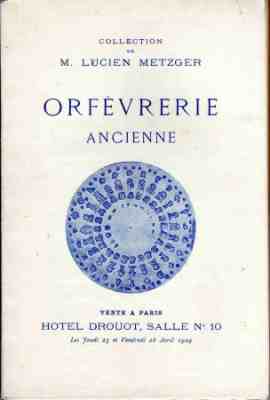
|
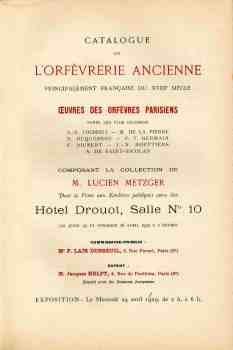 This auction offered on sale "Orfèvrerie
Ancienne, Principalement Francaise du XVIII
Siècle. Oeuvres Des Orfèvres Parisiens parmi les
plus célebres, A.-N. COUSINET - M.DE LA PIERRE -
N. DUQUESNOY - F.T. GERMAIN - F. JOUBERT - J.-
N. ROETTIERS - A. DE SAINT-NICOLAS
This auction offered on sale "Orfèvrerie
Ancienne, Principalement Francaise du XVIII
Siècle. Oeuvres Des Orfèvres Parisiens parmi les
plus célebres, A.-N. COUSINET - M.DE LA PIERRE -
N. DUQUESNOY - F.T. GERMAIN - F. JOUBERT - J.-
N. ROETTIERS - A. DE SAINT-NICOLAS
composant la collection de M. LUCIEN METZGER"
(Ancient silver, mostly French 18th century,
works of famous Paris silversmiths A.-N.
COUSINET - M.DE LA PIERRE - N. DUQUESNOY - F.T.
GERMAIN - F. JOUBERT - J.- N. ROETTIERS - A. DE
SAINT-NICOLAS,
belonging to the collection of M. LUCIEN METZGER)
The Hotel Drouot is the main auction house in
Paris. It is located on rue Drouot, in the 9th
Arrondissement. This is one of the leading art
markets of the world, especially for antiques,
Art Nouveau and Art Deco, Art of China and Japan,
books and so-called primitive arts. The Hotel
Drouot was inaugurated on 1 June 1852 and widely
transformed in the late 1980s. (translated
from French Wikipedia)
|
"A WORD per MONTH"
In this column we presents an
abstract from a page of the "What is? Silver Dictionary"
courtesy of

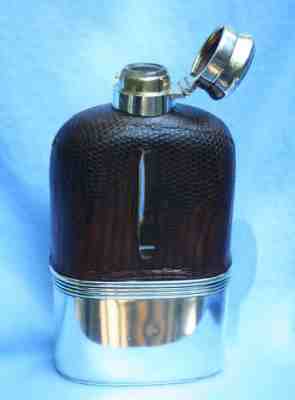
|
HIP FLASK
SADDLE FLASK
Hip flasks may have had their origin in the
pilgrim bottle or flask, commonly associated
with religious pilgrimages in medieval times.
The pilgrim flask is vessel with a body varying
from an almost full circle, flattened, to a pear
shape, with a short neck, spreading foot and,
generally, two loops on the shoulders.
Through the loops either a chain or cord was
passed for carrying the bottle to be slung over
the shoulder of the traveller or hung from a
saddle or for maintaining the stopper in place.......
more
|
"A BOOK ON MY SHELF"
In this column we present
books, new or ancient, dealing with silver in all its
aspects (history, marks, oddities...). This isn't a
"book review" but only a fair presentation of some
useful "tools" that anyone may have in the shelf of his
bookcase.
ASCAS members are invited to contribute to this column
(click to enlarge images)
The "book on my shelf" of this month presents:
CHATS ON
OLD SILVER
by Arthur Hayden
edited and revised by Cyril G.E. Bunt
Ernest Benn Limited, London
First published in 1915, second (revised) Edition
1949, this is the 1952 reprint
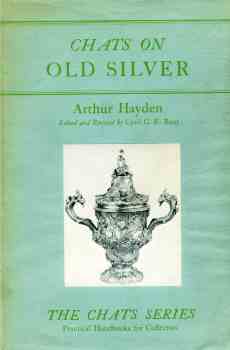 |
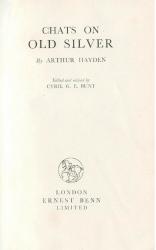 |
A commentator wrote
about this book: With some fifty pages of
plates and numerous illustrations of marks,
Chats on Old Silver forms a most valuable
handbook for the collector. The text
conveniently deals with the different types of
silverware and the comparison given of sales
prices today and when the book was first
published form an interesting feature. Cyril
G.E. Bunt, who so ably carried out the revision
of this edition was for many years on the staff
of the Victoria and Albert Museum and is well
known as a leading contributor to art journals
both in this country and abroad.
|
Closing our APRIL 2009 edition of
ASCAS Newsletter I hope you have appreciated its content.
Your comments, suggestions and advice will be of great
help.
My thanks to
Barry Arnol, Dominique Bochet, Andrew Brasch, Carmelo
Bruno Bruni, D. Burry, Jayne Dye, Kari Helenius,
Kimberly Karkov, Konstantin Kustanovich, Tony Mason,
Robert Massart, Erwin Mast, Brian Nichelson, David N.
Nikogosyan, Hugh Scrine, André Van den Kerkhove, for
their invaluable contributions.
Giorgio Busetto
Secretary
DISCLAIMER AND PRIVACY POLICY
ASCAS is a community of people having a
common interest in antique silver.
It is a non-profit association without
commercial links. Membership is open to whomever
has a true interest in this subject matter.
ASCAS has no real property and no fees are
requested nor accepted from members.
ASCAS keeps in touch with its members only
through periodical newsletters, e-mails and
web-site updating and ignores and is not
responsible for any other activity pursued by
its members.
Likewise, ASCAS is not responsible for opinions,
evaluation and images displayed, and in any form
published or supplied for publication, by its
members who, in any case, maintain the property
of their works and assure the respect of
national and international legislation about
Intellectual Property.
ASCAS does not have the full addresses of its
members (only town, country and e-mail address
are requested for membership).
ASCAS handles and protects with care its members
e-mail addresses, will not disclose the
addresses to third parties, will use this
information only to reply to requests received
from members and for communications strictly
related to its activity.
These rules are expressly accepted by submitting
the membership request.
|
|
|
|
|
|
 newsletter # 59 - APRIL 2009
newsletter # 59 - APRIL 2009



